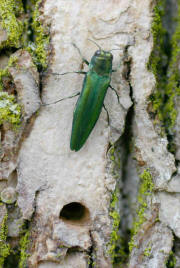|
 Column Column
Emerald Ash Borer Found In Logan,
Menard, and Sangamon Counties
By John Fulton
 Send a link to a friend
Send a link to a friend
[October 11, 2014]
With the presence of emerald ash borer
confirmed in all three of our counties, the “What Next?” questions
are coming in fast and furious. They rank only second to “Would you
look at my ash tree?” As for looking at the ash trees, it is
physically impossible to look at all of them. If you want to provide
pictures or drop samples by, we can try and deal with requests in
that manner. In the weeks ahead, most communities will roll out
their control and containment plans because of the findings – so
stay tuned for further information.
|
|
 Most communities have an abundance of the various ash trees, as
they were frequently used as replacements for the American Elm
trees afflicted by Dutch Elm Disease. To answer the other
question, Jennifer Fishburn, University of Illinois Extension
Horticulture Educator in the Logan, Menard, and Sangamon Unit,
has provided the following information: Most communities have an abundance of the various ash trees, as
they were frequently used as replacements for the American Elm
trees afflicted by Dutch Elm Disease. To answer the other
question, Jennifer Fishburn, University of Illinois Extension
Horticulture Educator in the Logan, Menard, and Sangamon Unit,
has provided the following information:
The Illinois Department of Agriculture announced on October 6,
2014 that emerald ash borer had been identified in several
counties including Logan, Menard and Sangamon counties.
This destructive, non-native pest feeds on North American ash
species (Fraxinus sp.). This includes white ash, green ash,
black ash and blue ash trees. In Illinois white and green ash
are the most commons species. This does not include mountain ash
which is not a true ash. Emerald ash borer attacks both healthy
and stressed ash trees.
Ash tree can be identified by opposite, pinnately compound
leaves. A leaf has 5 to 9 glossy, dark green leaflets. Young
bark of ash trees is usually flaky. Mature trees have light-gray
to gray-brown bark, with ridges and deep furrows forming
diamond-shaped areas. For information on “Ash Tree
Identification,” view handout from Michigan State University
Extension,http://www.emeraldash
borer.info/files/E2942.pdf

The beetle is native to Asia, and was first discovered in North
America in southeastern Michigan in the summer of 2002. It seems
that the pest arrived in Michigan via infested wood packaging
material. Through hitchhiking on firewood, nursery stock and
logs, Emerald Ash Borer infestations are now in Colorado,
Georgia, the East coast and throughout the Midwest.
Signs of infestation include die-back beginning in the upper
third of the tree and progressing downward, serpentine-shaped
(or S-shaped) tunnels just beneath the bark, vertical splits in
the bark and increased woodpecker activity. One-third to
one-half of the branches may die in one year. Most of the canopy
will be dead within two years of observed symptoms. Additional
signs include the presence of the adult metallic-green beetles
on or around ash trees, thinning and yellowing leaves, 1/8 inch
diameter D-shaped holes (about the size of a BB) in the bark of
the trunk or branches, and shoots growing from the base of the
tree (epicormic shoots). Infested trees may not show physical
signs of damage for four to six years.

[to top of second column] |

The emerald ash borer, Agrilus planipennis, adult is a small
metallic-green beetle, about 3/8 to 5/8 inch long, and 1/8 inch
wide. The adult feeds on ash foliage but causes little damage to
the leaves.
Emerald ash borer larvae feed on the inner bark of ash trees.
These tunnels cut off the flow of nutrients and water between
the tree’s roots and canopy, thus starving the tree. The larvae
are flat, legless, heavily fragmented, creamy white and reach
about 1 inch in length.
If you have an ash tree, what now? Ash trees that are
treated with insecticide can be saved, but before beginning
treatment, consideration should be given to assessing the health
and vigor of the tree.
Unhealthy trees with more than half of their leaves missing,
lacking vigor, planted in a poor site, or having bark splits or
water sprouts are not likely to respond well to treatments.
Avoid treatment of trees showing more than 50 percent canopy
decline; these ash trees are unlikely to recover even if
treated.
Healthy trees showing vigorous growth, that enhance landscape
value and showing few signs of decline are good candidates for
treatment. University of Illinois recommends starting
insecticide treatments when your tree is within 15 miles of an
EAB infestation, or if you are within a county that is
quarantined. For information on treatment options view
“Insecticide Options for Protecting Ash Trees from Emerald Ash
Borer” publication which can be found on the Emerald Ash Borer
website at
http://www.emeraldashborer
.info/files/Multistate_EAB_Insecticide_
Fact_Sheet.pdf
For information on proper identification of an ash tree, photos
of the emerald ash borer and other problems of ash trees, visit
the Emerald Ash Borer website,
http://www.emeraldashborer.info
[By JOHN FULTON, COUNTY EXTENSION
DIRECTOR SERVING LOGAN, MENARD, AND SANGAMON COUNTIES]
 |